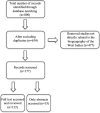Biogeography of the West Indies: A complex scenario for species radiations in terrestrial and aquatic habitats
- PMID: 33767811
- PMCID: PMC7981229
- DOI: 10.1002/ece3.7236
Biogeography of the West Indies: A complex scenario for species radiations in terrestrial and aquatic habitats
Abstract
Studies of the biogeography of the West Indies are numerous but not all taxonomic groups have received the same attention. Many of the contributions to this field have historically focused on terrestrial vertebrates from a perspective closely linked to the classical theory of island biogeography. However, some recent works have questioned whether some of the assumptions of this theory are too simplistic. In this review, we compiled information about the West Indies biogeography based on an extensive and rigorous literature search. While we offer some background of the main hypotheses that explain the origin of the Caribbean biota, our main purpose here is to highlight divergent diversification patterns observed in terrestrial versus aquatic groups of the West Indian biota and also to shed light on the unbalanced number of studies covering the biogeography of these groups of organisms. We use an objective method to compile existing information in the field and produce a rigorous literature review. Our results show that most of the relevant literature in the field is related to the study of terrestrial organisms (mainly vertebrates) and only a small portion covers aquatic groups. Specifically, livebearing fishes show interesting deviations from the species-area relationship predicted by classical island biogeography theory. We found that species richness on the Greater Antilles is positively correlated with island size but also with the presence of elevations showing that not only island area but also mountainous relief may be an important factor determining the number of freshwater species in the Greater Antilles. Our findings shed light on mechanisms that may differently drive speciation in aquatic versus terrestrial environments suggesting that ecological opportunity could outweigh the importance of island size in speciation. Investigations into freshwater fishes of the West Indies offer a promising avenue for understanding origins and subsequent diversification of the Caribbean biota.
Keywords: West Indies; biogeography; island; livebearing fishes.
© 2021 The Authors. Ecology and Evolution published by John Wiley & Sons Ltd.
Conflict of interest statement
The authors have declared that no competing interests exist.
Figures




Similar articles
-
The West Indies as a laboratory of biogeography and evolution.Philos Trans R Soc Lond B Biol Sci. 2008 Jul 27;363(1502):2393-413. doi: 10.1098/rstb.2007.2068. Philos Trans R Soc Lond B Biol Sci. 2008. PMID: 17446164 Free PMC article. Review.
-
Determinants of bird species richness, endemism, and island network roles in Wallacea and the West Indies: is geography sufficient or does current and historical climate matter?Ecol Evol. 2014 Oct;4(20):4019-31. doi: 10.1002/ece3.1276. Epub 2014 Oct 2. Ecol Evol. 2014. PMID: 25505528 Free PMC article.
-
The ecological and evolutionary dynamics of inselbergs.Biol Rev Camb Philos Soc. 2025 Apr;100(2):481-507. doi: 10.1111/brv.13150. Epub 2024 Oct 1. Biol Rev Camb Philos Soc. 2025. PMID: 39352171 Review.
-
Towards a synthesis of the Caribbean biogeography of terrestrial arthropods.BMC Evol Biol. 2020 Jan 24;20(1):12. doi: 10.1186/s12862-019-1576-z. BMC Evol Biol. 2020. PMID: 31980017 Free PMC article.
-
Invasive plant species in the West Indies: geographical, ecological, and floristic insights.Ecol Evol. 2017 Apr 28;7(13):4522-4533. doi: 10.1002/ece3.2984. eCollection 2017 Jul. Ecol Evol. 2017. PMID: 28690783 Free PMC article.
Cited by
-
A phylogeny of the genus Limia (Teleostei: Poeciliidae) suggests a single-lake radiation nested in a Caribbean-wide allopatric speciation scenario.BMC Res Notes. 2021 Nov 25;14(1):425. doi: 10.1186/s13104-021-05843-x. BMC Res Notes. 2021. PMID: 34823576 Free PMC article.
-
Lineages of Fractal Genera Comprise the 88-Million-Year Steel Evolutionary Spine of the Ecosphere.Plants (Basel). 2024 Jun 5;13(11):1559. doi: 10.3390/plants13111559. Plants (Basel). 2024. PMID: 38891367 Free PMC article.
-
No geographical differences in male mate choice in a widespread fish, Limia perugiae.Behav Ecol. 2024 Feb 6;35(2):arae008. doi: 10.1093/beheco/arae008. eCollection 2024 Mar-Apr. Behav Ecol. 2024. PMID: 39371452 Free PMC article.
-
Diversification dynamics in Caribbean rain frogs (Eleutherodactylus) are uncoupled from the anuran community and consistent with adaptive radiation.Proc Biol Sci. 2023 Jan 11;290(1990):20222171. doi: 10.1098/rspb.2022.2171. Epub 2023 Jan 11. Proc Biol Sci. 2023. PMID: 36629104 Free PMC article.
-
A new species of Neohagenulus Traver, 1938 from Hispaniola (Ephemeroptera, Leptophlebiidae, Hagenulinae, Hagenulini).Zookeys. 2021 Nov 10;1070:41-50. doi: 10.3897/zookeys.1070.73484. eCollection 2021. Zookeys. 2021. PMID: 34819770 Free PMC article.
References
-
- Acevedo‐Rodríguez, P. , & Strong, M. T. (2008). Floristic richness and affinities in the West Indies. Botanical Review, 74(1), 5–36. 10.1007/s12229-008-9000-1 - DOI
-
- Algar, A. C. , & Mahler, D. L. (2016). Area, climate heterogeneity, and the response of climate niches to ecological opportunity in island radiations of Anolis lizards. Global Ecology and Biogeography, 25, 781–791. 10.1111/geb.12327 - DOI
-
- Ali, J. R. (2012). Colonizing the Caribbean: Is the GAARlandia land‐bridge hypothesis gaining a foothold? Journal of Biogeography, 39, 431–433. 10.1111/j.1365-2699.2011.02674.x - DOI
-
- Alonso, R. , Crawford, A. , & Bermingham, E. (2012). Molecular phylogeny of an endemic radiation of Cuban toads (Bufonidae: Peltophryne) based on mitochondrial and nuclear genes. Journal of Biogeography, 39, 434–451. 10.1111/j.1365-2699.2011.02594.x - DOI
-
- Barbour, T. , & Matthew, W. D. (1916). Some remarks upon Matthew's “climate and evolution”. Annals of the New York Academy of Sciences, 27(1), 1–15. 10.1111/j.1749-6632.1916.tb55181.x - DOI
Publication types
Associated data
LinkOut - more resources
Full Text Sources
Other Literature Sources

